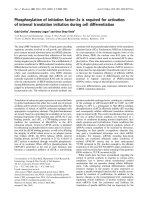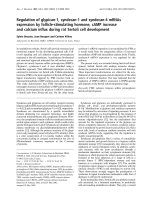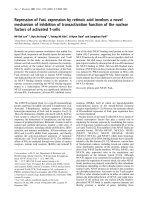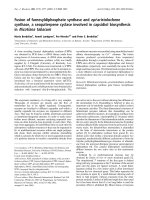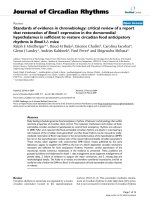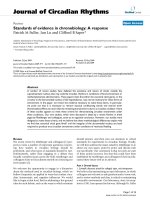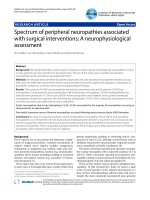Báo cáo y học: " Standards of resuscitation during inter-hospital transportation: the effects of structured team briefing or guideline review - A randomised, controlled simulation study of two microinterventions" ppsx
Bạn đang xem bản rút gọn của tài liệu. Xem và tải ngay bản đầy đủ của tài liệu tại đây (569.57 KB, 11 trang )
ORIGINAL RESEARCH Open Access
Standards of resuscitation during inter-hospital
transportation: the effects of structured team
briefing or guideline review - A randomised,
controlled simulation study of two micro-
interventions
Christian B Høyer
1*
, Erika F Christensen
2
, Berit Eika
1
Abstract
Background: Junior physicians are sometimes sent in ambulances with critically ill patients who require urgent
transfer to another hospital . Unfamiliar surroundings and personnel, time pressure, and lack of experience may
imply a risk of insufficient treatment during transportation as this can cause the physician to loose the expected
overview of the situation. While health care professionals are expected to follow complex algorithms when
resuscitating, stress can compromise both solo-performance and teamwork.
Aim: To examine whether inter-hospital resuscitation improved with a structured team briefing between physician
and ambulance crew in preparation for transfer vs. review of resuscitation guidelines. The effect parameters were
physician team leadership (requesting help, delegating tasks), time to resuscitation key elements (chest
compressions, defibrillation, ventilations, medication, or a combination of these termed “the first meaningful
action”), and hands-off ratio.
Methods: Participants: 46 physicians graduated within 5 years. Design: A simulation intervention study with a
control group and two interventions (structured team briefing or review of guidelines). Scenario: Cardiac arrest
during simulated inter-hospital transfer.
Results: Forty-six candidates participated: 16 (control), 13 (review), and 17 (team briefing). Reviewing guidelines
delayed requesting help to 162 seconds, compared to 21 seconds in control and team briefing groups (p = 0.021).
Help was not requested in 15% of cases; never requesting help was associated with an increased hands-off ratio,
from 39% if the driver’s assistance was requested to 54% if not (p < 0.01). No statistically significant differences
were found between groups regarding time to first chest compression, defibrillation, ventilation, drug
administration, or the combined “time to first meaningful action ”.
Conclusion: Neither review nor team briefing improved the time to resuscitation key elements. Review led to an
eight-fold increase in the delay to requesting help. The association between never requesting help and an
increased hands-off ratio underpins the importance of prioritising available resources. Other medical and non-
medical domains have benefited from the use of guidelines reviews and structured team briefings. R eviewing
guidelines may compromise the ability to focus on aspects such as team leading and delegating tasks and
warrants the need for further studies focusing on how to avoid this cognitive impairment.
* Correspondence:
1
Centre for Medical Education, Faculty of Health Sciences, University of
Aarhus, Denmark
Full list of author information is available at the end of the article
Høyer et al. Scandinavian Journal of Trauma, Resuscitation and Emergency Medicine 2011, 19:15
/>© 2011 Høyer et al; licensee BioMed Central Ltd. This is an Open Access article distributed under the terms of the Creative Commons
Attribution License ( which permits unrestricted use, distribution, and reproduction in
any medium, provided the original work is properly cited.
Introduction
Urgent inter-hospital transfer poses a risk of making
things worse to the patient: urgent transfer from sec-
ondary hospitals to tertiary hospitals is associated with
increased mortality and morbidity [1-5].
Junior physicians are often expected to manage urgent
inter-hospital transfer of critically ill pati ents needing
higher levels of di agnostic or therapeutic interventions,
e.g. percutaneous coronary intervention (PCI). The
patient’s health may be endangered by the consequences
of, e.g., staff working under time pressure, unfamiliar
surroundings, unusual equipment, unaccustomed
co-workers or unfamiliar shifts in responsibi lities and
roles, all potentially leading to insufficient preparation
or use of e quipment, or sub-o ptimal diagnosis or treat-
ment [1,2,4-7]. A common denominator underlying
these examples is, that they can be contributed either to
insufficient training or to lack of experience [3].
Information overload
Maintaining focus in complex situations, such as during
resuscitation, is challenged by the flood of clinical infor-
mation to be collected, analysed, prioritised, and
responded to (i.e. changes in the patient’ scolouror
breathing pattern, the relevance of equipment alarms,
and the importance of feedback from other team mem-
bers). This flood of inform ation may inundate the physi-
cian and cause a state of information overload which in
turn may reduce cognitive skills, impair decision mak-
ing, and decrease performance [8-11].
Resuscitation guidelines as a filtered source of knowledge
One way to counteract information overload is to use
filtered sources such as guidelines. Resuscitation guide-
lines constitute an organised summary of accumulated
expert-level knowledge in the field [12]. Probably on
this foundation, the mantra throughout resuscitation
education has for many years been guidelines, guide-
lines, guidelines. However, as resuscitation is not only a
matter of technical skills, like compression depth and
frequency, it is also necessary to l ook at resu scitation as
a whole. In order to identify weak spots in the care of
acut ely ill patients, it is necessary to apply an integrated
approach considering not only the role of guidelines,
but also factors as surroundings, equipment, and team
work.
Team work and team briefing
Team work is essential in resuscitation, as it combines
professionals’ skills and knowledge both within and
between specialties [13,14]. A strategy to improve this
intra- and inter-disciplinary cooperation is the use of
team briefings, that is, a face-to-face meeting that
ensures relevant information is shared within the team
[4,13-15]. The benefit of team briefings, often supp orted
by the use of checklists, has been e stablished in the lit-
erature, e.g. by lowering the incidence of wrong side
surgery or improving the overall performance [4,15-18].
In a previous simulation study on junior physician
skills and behaviour in resuscitation, [5] we assessed the
technical quality of resuscitation in a scenario with a
simulated cardiac arrest victim. The scenario was
designed as an inter-hospital transfer of a simulated
patient with acute coronary syndrome (ACS) who devel-
oped cardiac arrest during the transfer. A total of 72
junior physicians participated in the simulations that
were performed in genuine ambulances with ambulance
crew as team members. We found junior physicians’
were deficient in team leader skills, especially in terms
of delegation of manual tasks. Another finding was wide
variations in key-elements in resuscitation, such as ti me
to first chest compression and first defibrillation. How-
ever, it could not be determined whether this was
caused by insufficient knowledge and skills in resuscita-
tion guidelines or by deficient team leader skills.
Knowledge about guidelines is without doubt crucial,
but also team briefings, often structured by checklists,
has successfully improved performance and reduced
errors in medical practice [15-18]. Therefore, we want
to test whether the standard of resuscitation is improved
by review of guidelines or byachecklistbasedstruc-
tured briefing, both performed just prior to the
simulation.
Aim
Thi s study examines if introduction of one of two clini-
cally applicable micro-interventions (review of guidelines
or structur ed team briefi ng) affect the standard of team
leadership and resuscitation in a simulated cardiac arrest
scenario (during inter-hospital transfer of a simulated
patient wit h ACS) by c ompariso n of three g roups (con-
trol and two intervention groups).
Methods
The study design was an observ ational simulation study
including three g roups: a cont rol group, a review group,
and a team briefing group.
Participants, recruitment, and ethics
Eligible participants wer e physicians who graduated
within the last five years at time of the study, and func-
tioned as ‘ front-line personnel’ in Internal Medicine
departments with acute admissions in ‘Central Region
Denmark’. The participants were recruited via consul-
tants responsible for educating junior physicians in each
department, and simulations were held during work
Høyer et al. Scandinavian Journal of Trauma, Resuscitation and Emergency Medicine 2011, 19:15
/>Page 2 of 11
hours on dates with the largest possi ble number of par-
ticipa nts available. Under these circumstances, 46 physi-
cians were able to participate. The participation was
voluntary and data kept anonymous and confidential.
Neither The Central Denmark Region Committees on
Biomedical Research Ethics nor the Danish Data Protec-
tion Agency stipulated approval for this stud y. Although
not legally necessary, we obtained informed consent
from the participants in order to adhere to the higher
standards for biomedical research.
Equipment, set-up, and scenario
The simulation was held in a genuine and fully opera-
tional ambulance with usual personnel and standard
equipment. The crew (a paramedic and an emergency
medical technician (EMT)) were qualified in BLS and
defibrillation, among other things, but not in adminis-
tration of intra-venous drugs. During the entire simula-
tion, the paramedic stayed in the patient’s compartment.
The EMT acted as the driver when the simulation was
initiated, but the physician could request his assistance
in the patient’s compartment at any time. The facilitator
(the first author of this paper) initiated the simulation
by verbally announ cing that the ambulance was now on
the road and approximately halfway between the two
hospitals. A manikin was placed supine on the st retcher,
and the cardiac rhythm, peripheral blood saturation, and
blood pressure were simulated via computer control
[19,20]. Prior to the simulation, intravenous accesses
were established, supplemental oxygen provided, and
self-adhesive defibrillation pads attached.
The case was standardised and involved a patient with
ACS requiring transfer to a tertiary hospital fo r percuta-
neous coronary intervention (PCI). During the transfer,
the simulated patient developed a ventricular fibrillation
(VF) cardiac arrest which was refractory to t reatment
for f ive minutes (Table 1). F or the following three min-
utes delivery of DC-shock would induce return of spon-
taneous circulation (ROSC), which otherwise would
happen spontaneously no later than eight minutes after
the onset of VF in order not to burden the participant
emotionally. The ambulance crew was instructed to be
helpful but leave the task assignment and treatment
decisions to the physician.
Randomisation
Randomisation was done on an individual basis by let-
ting the physician draw a closed envelope prior to the
simulation. The envelopes included one of the numbers
1, 2, or 3, and were made, as well as shuffled, by an
independent person prior to the entire study sequence.
The intervention s could not, by their nature, be blinded
to the participant, the ambulance crew, or the investiga-
tor who conducted the simulation. However, as the
participants did not know th e nature of the interven-
tions, they were not able to discern to which group they
were randomised.
Control group (n = 16)
Physicians randomised to th e control group were given
a short, written outline of the case and a verbal outline
of the features of t he manikin. The physicians rando-
mised to the two intervention groups were introduced
similarly.
Team briefing group (n = 17)
Physicians in the team briefing group were given a
checklist reflecting the headlines in the resuscitation
algorithm (Figure 1). The checklist was developed by
the authors and items primarily based on our observa-
tions from our first study [5]. The physicians were
instructed to utilize the time they felt was necessary to
read the checklist and to brief the ambulance crew. To
guide the discussion, each item was followed by five
possibilities: 1) ambulance crew only, 2) mostly ambu-
lance crew, 3) evenly distributed, 4) mostly physician,
and 5) physician only. The optimum allocation of tasks,
as illustrated in Figure 1, was defined on a consensus
decision between the authors, based on formal informa-
tion about the general qualifications and competencies
Table 1 Timeline of experimental protocol
Events in the ambulance
“Departure”
(T
-3 min
)
Initiation of the simulation:
Facilitator announces: “the ambulance is on the road -has
been driving for app. 30 minutes.”
Patient awake and stable, sinus rhythm and SpO
2
99% on
monitor.
Engages in a conversation with the physician to attract
the physician’s focus.
If physician stays focused on the monitor/defibrillator,
conversation-time is prolonged.
T
-0:15 min
Patient develops VT, pulse rate 180, blood pressure 80/50
mmHg.
Complains about nausea and dizziness.
T
0 min
Rhythm changes to VF.
Unresponsive, vital signs absent
VF is intractable in the following 5 minutes, regardless of
the treatment given.
T
5 min
VF changes to pVT sensitive to defibrillation.
pVT converts to SR if defibrillated
EMT offers help twice - enters only the patients’
compartment if accepted by the physician.
T
8 min
Sinus rhythm reappears, regardless of the treatment given.
T
end
End of simulation. The patient is now somewhat
responsive.
T
0
indicates the time of onset of ventricular fibrillation, and
the subscript
text
describes the timing of events before and after T
0
. Although parked during
the simulation, it was clearly stated when the ambulance was “on the road.”
Abbreviations: SpO
2
: peripheral blood saturation, VT: ventricular tachycardia,
VF: ventricular fibrillation, pVT: pulseless ventricular tachycardia, SR: sinus
rhythm, ECG: Electrocardiogram, EMT: Emergency Medical Technician.
Høyer et al. Scandinavian Journal of Trauma, Resuscitation and Emergency Medicine 2011, 19:15
/>Page 3 of 11
held by the physicians and the ambulance crew, respec-
tively (for example, the ambulance crew were not quali-
fied to do intravenous injections).
Review group (n = 13)
The physicians in the guideline-review group were given
the current resuscitation guidelines published by the
Danish Resuscitation Council (DRC) and were told to
use the time they felt was necessary to study the guide-
lines folder prio r to initiation of the simulation [21]. It
should be noted, that the participants did not receive
any education or training in the guidelines in connec-
tion to the study. The guidelines folder (Figure 2) was
the official DRC translation to Danish of the English
version of the guidelines published by the European
Resuscitation Council in 2005 [22].
Data collection, indicators, and analysis
Prior to participation, a questionnaire was filled in
including items about age, gender, date of birth, date
and place of graduation, and participation in pre- and
postgraduate resuscitation courses. All simulations,
including interventions, briefings, and debriefings were
rec orded on video, and data was subsequently extracte d
by manual review of the recordings. The time allocated
to reviewing guidelines or conducting team briefing was
recorded, as was the time for chest compressions, defi-
brillations, ventilations, ad ministration of pharmacologi-
cal agents, and time elapsed until the physician
requested assistance from the driver. Hands-off ratio
was defined as the total time without chest compres-
sions divided by the total time with a non-perfusing car-
diac rhythm (in this case the time from debut of VF to
ROSC).
Effect parameters
The following effect parameters w ere used to compare
the three groups:
The evaluation of the junior physicians team leader-
ship in relation to the ambulance crew was based on
whether the physician a) requested help, and in case this
happened, when it was done, and b) delegated tasks,
and, in case of this, which tasks. Delegated tasks were
defined as a ny task the physician asked the ambulance
crew to perform, whether or not they would have
initiated these by themselves in a real situation (chest
compressions, ventilations, or alike). The evaluation of
the resuscitation standard was made by measurement of
the elapsed time from debut of ventricular fibrillation to
the initiation of a) defibrillation, b) chest compression,
c) ventilation, d) pharmacologic treatment, and e)
hands-off ratio (the time without ongoing chest com-
pression over the time in cardiac arrest).
To adjust for the somewhat competing nature of the
actions a)-d) mentioned above, the actions wer e collated
in one variable describing the “first meaningful action”,
that is, the time elapsed from the debut of ventricular
fibrillation to the initiation of any of those (defibrilla-
tion,chestcompression,ventilation,orpharmacologic
treatment).
Statistics
Video recordings from a digital surveillance camera
mounted in the ambulance documented all simula-
tions, and recordings were continuously time-stamped
by the camera with a built-in on-screen digital clock.
The data were entered in an Access 2003 database[23]
and statistical analysis performed with Stata/IC 10.1
[24]. Nominal data were expected to have a non-Gaus-
sian distribution and wide variations, so the Kruskal-
Wallis equality-of-populations rank-test was used [5].
The data are presented as median (range) [1
st
;3
rd
quartiles]. Pearson’ s c
2
-test was used on categorical
data. Three simulations were randomly selected and
used for calculation of in tra- and inter-observer varia-
bility. All simulations were reviewed twice by two
independent persons (a physician and a medical stu-
dent), as well as by the first author of this paper. The
inter- and intra-observer correlation coefficients were
calculated using Stata/IC 10.1 [24].
&UHZ
RQO\
&UHZ
PRVWO\
(TXDOO\
GLYLGHG
3K\VLFLDQ
PRVWO\
3K\VLFLDQ
RQO\
'LDJQRVHFDUGLDFDUUHVW
3HUIRUPFKHVWFRPSUHVVLRQV
3HUIRUPYHQWLODWLRQV
$VVHVVFDUGLDFUK\WKP(&*
'HFLGHWRGHILEULOODWH
2SHUDWHWKHGHILEULOODWRU
&KRRVHGUXJV
3UHSDUHGUXJV
,QMHFWGUXJV
.HHSWUDFNRQWLPH
Figure 1 Team briefing checklist. Items used in the team briefing
checklist. To guide the discussion, each item was followed by five
possibilities: 1) crew only, 2) crew mostly, 3) evenly divided, 4)
physician mostly, and 5) Physician only. The optimum allocation of
tasks was based on qualifications, competencies, and experience (for
example, the ambulance crew was not qualified to administer
intravenous injections). The optimum allocation, in the authors’
opinion, is marked for each item (X). ECG: electro-cardio-gram.
Høyer et al. Scandinavian Journal of Trauma, Resuscitation and Emergency Medicine 2011, 19:15
/>Page 4 of 11
Results
Participants
A modified Consort flowchart is shown in Figure 3. Eli-
gibleforthestudywere258physicians;46were
recruited. Median age of participants was 29 years (27-
44) [27; 31), sex ratio was 1:1 (23 males, 23 females)
and average graduation age 1 year. No statistic ally sig-
nificant differences between the groups were identified.
The median time used were 104 seconds (51-201) [57;
144] for reviewing resuscitation guidelines and 203 sec-
onds (111-329) [157; 293] for conducting a team
briefing.
Team leadership in relation to ambulance personnel:
requesting help
In the review group, help was requested later than in
the other groups: median time was 162 seconds com-
pared to 21 seconds in both the control and the team
briefing groups (Kruskal-Wallis, p = 0.015, Table 2,
Figure 4). The physicians did not request the driver’ s
help at all in 15% of cases (7/46): control group 19% (3/
16), review group 23% (3/13), and team briefing group
6% (1/17), with no statistical differences between groups.
Never calling for help was associated with a statistically
significant increase in hands-off ratio (Kruskal-Wallis,
p = 0.016). The median hands- off ratio if help was not
requested was 54%, compared to 39% if the driver ’s
assistance in the patient’s compartment was requested
(p < 0.01).
Team leadership in relation to ambulance personnel:
delegating tasks
Chest compressions were delegated entirely to the
ambulance crew in 63% (10/16) and 65% (11/17) of
cases in control and team briefing groups, respectively,
but only 31% (4/13) in the review group. Defibrillation
was delegated entirely to the ambulance crew in 62%
(6/16), 53% (9/17), and 15% (2/13) and ventilations in
69% (11/16), 82% (14/17), and 69% (9/13), in the con-
trol, team briefing, and review groups, respectively.
Statistically significant differences were not found.
Drug administration was never delegated to the ambu-
lance crew.
Evaluation of the resuscitation standard: time to initiation
of procedures
Comparisons between control, review, and team briefing
groups in terms of time to first chest compression, d efi-
brillation, ventilation, and pharmacologic treatment
revealed no significant differences (Table 2, Figure 5).
The time elapsed from debut of the cardiac arrest to the
first meaningful action (chest compression, defibrillation,
ventilation, or pharmacologic treatment) showed no sta-
tistically significant differences (Table 2, Figure 6).
Evaluation of the resuscitation standard: hands-off ratio
The hands-off ratio did not differ significantly between
the three groups; in the control group it was 42% (21-
86) [36; 50], in the review group 44% (34-59) [38; 50],
Figure 2 Danish ALS-guidelines folder. The Danish version of ALS guidelines handed out to the participants in the “review” group. The figure
shows one page of the folder’s four pages. English translations of the Danish text are given in (parentheses).
Høyer et al. Scandinavian Journal of Trauma, Resuscitation and Emergency Medicine 2011, 19:15
/>Page 5 of 11
Physicians in
Central Region Denmark
N=2847
Internal Medicine departments
n=954
Graduation age 5 years or less
n=258
Participants
n=46
Randomized
(N=46)
Control
n=16
Team briefing
n=17
Unassisted review
n=13
Not able to participate
n=212
Graduation age 6 years or more
n=696
Other departments
n=1893
Figure 3 Participants. Modified Consort- flowchart diagram showing the entire population from which the participants were chosen. A total of
258 physicians were eligible for enrolment in the study, of which 46 (18%) participated. Reasons why eligible physicians could not participate
were numerous; e.g. participants who had already volunteered to participate were hindered in participation due to extreme workload, changes
in work-schedule, exhaustion after night-duty, or alike.
Høyer et al. Scandinavian Journal of Trauma, Resuscitation and Emergency Medicine 2011, 19:15
/>Page 6 of 11
and in the team briefing group 37% (24-60) [34; 44]
(Kruskal-Wallis, p = 0.27).
The intra-observer variability coefficients were 0.9966,
0.9981, and 0.9971, respectively, and the inter-observer
variability coefficients were 0.9897, 0.9913, and 0.9906,
respectively.
Discussion
An unexpected finding in our study was that the review
of guide lines prior to the simulation test was associated
with a statistically significant, almost eight-fold, increase
in the delay in requesting the EMT to help in the
patient’s compartment.
This finding suggests a possible ‘ inhibitory’ effect of
reviewing guidelines on resource thinking. A possible
explanation is that focusing the working memory on
technical guidelines impairs the physicians’ overall per-
spective, as working memory has a limited capacity. The
limited capacity may again contribute to information
overload and consequently compromise the overview.
It has been documented, that lack of overview jeopar-
dize teamwork and consequently decrease the standard
of the resuscitation [4,12,16,25-30].
Although not statistically significant, a similar pattern
of lowest delegation rate in the review group than in the
other two groups was seen in del egation of che st com-
pressions and defibrillation.
Hands-off ratio
The incidence of successful resuscitation, in real life,
incre ases significantly with the per formance of on-going
chest compressions [ 31-35]. Therefore, the hands-off
ratio may be the most important parameter in the eva-
luation of resuscitation tests [36]. Never calling for help
from the driver was associated with a statistically signifi-
cant increase in hands-off ratio, rising from 39% if help
was requested to 54% if not (p < 0.01). This finding sug-
gests that stopping the ambulance and unifying all avail-
able human resources in the patient’s compartment may
be better than keeping the ambulance moving, thereby
leaving the EMT in the driver’s cabin.
Strengths and limitations
This simulation study was performed in an authentic
setting, as a real ambulanc e was used and the EMTs on
duty on the day of the experiment comprised the team
together with the junior physician studied. By choosing
this model, it beca me possible to study the isolated per-
formance of a junior physician working in a small resus-
citation team as opposed to a larger, in-hospital team,
with senior physicians taking the lead.
The small-intervention format was chosen because the
interventions should be easy to administer, should cause
no delay in resuscitation attempts, and, in case of suc-
cess, be easy to implement. The interventions were
tested on junior physicians because we had previously
shown how this gro up of physicians showed large varia-
tions in their resuscitation skills [5].
While simulation offers many advantages, it also has
potential problems. First, it is impossible to keep all
variables completely stable, as different EMTs and
ambulances were used according to time and place for
the simulations. Second, th e set-up incre ases the com-
plexities of the tasks facing the junior physician because
he or she has to deal with a number of unfamiliar chal-
lenges: should medicine be prepared in syringes in
advance, where to put the medicine bag, and where to
place oneself, just to mention a few choices that must
be made by the junior physician. These drawbacks and
potential sources of bias of our “mobile laboratory” are,
however, worthwhile in our opinion, as the setting
allows us to get a better understanding of the real per-
formance of young physicians compared to a co nven-
tional laboratory setting.
Table 2 Time for key resuscitation procedures since
debut of ventricular fibrillation
Minimum 1
st
quartile
Median 4
th
quartile
Maximum
Time to request for help *
Control (n =
13)
1 15 21 49 530
Team briefing
(n = 16)
1 5 21 39 111
Review (n =
10)
14 41 162 224 364
Time to first chest compression
Control 17 26 36 55 276
Team briefing 8 22 38 51 86
Review 15 31 40 51 71
Time to first defibrillation
Control 17 31 64 75 168
Team briefing 18 40 63 84 322
Review 18 38 58 90 213
Time to first ventilation
Control 30 40 53 79 114
Team briefing 37 56 64 81 128
Review 36 49 62 79 130
Time to first pharmacologic treatment
Control 34 210 232 257 365
Team briefing 102 227 291 365 399
Review 142 173 261 331 437
Time to first meaningful action
Control 17 19 27 35 74
Team briefing 8 22 36 46 57
Review 15 26 37 43 60
Høyer et al. Scandinavian Journal of Trauma, Resuscitation and Emergency Medicine 2011, 19:15
/>Page 7 of 11
Participants were all volunteers. This could introduce
bias if only physicians proficient in ALS - or feeling so,
at least - would participate, perhaps after refreshing
guidelines. If this was the case, the results may be even
more relevant as these would then reflect the better
part of the group and thereby overestimate the skills in
the underlying population. Regarding the number of
participants, an unfortunate, but frequent, problem was,
that participants who had already volunteered to partici-
pate were hindered in participation due to extreme
workload, changes in work-schedul e, exhaustion after
night-duty, or ali ke. This caused the number of partici-
pants to be lower than we expected from our previous
experiences [5].
Comparisons of the three groups (control, team brief-
ing, and review) showed no differences when it came to
technical resuscitation skills. This could be because the
interventions were too small-scaled to trigger results.
However, it is also possible that the lack of statistically
significant effects is due to the possibility of a type 2
error (rejecting an effect that is there) due to small sam-
ple sizes (13, 16, and 17 participants in the groups,
respect ively). Another explanation coul d be the possibi-
lity of a ceiling effect, that is, if the participants had
high l evels of resuscitation skills before the experiment
it would leave little room for improvement. Also, the
intra-group variation was large and might have out-
weighed the inter-group variation and thereby masked
possible differences. Finally, impreci se data co llection
could also be an explanation for the large variations,
however, as the intra- and inter-observer variability
coefficients were all very high (> 0.98) this is unlikely.
Perspectives
Fixation errors are known from clinical practise: infor-
mation that should change the course of the resuscita-
tion attempt is ignored (the team leader believes cardiac
arrest is due to myocardial infarction and ignore s intel-
ligence about ingestion of toxic substances, e.g.) [37].
The underlying mechanism may be inattentional blind-
ness, a term from the psychological literature, describing
how a preoccupied mind may fail to shift atte ntion
intentionally [38]. Rehearsing guidelines may cause the
physician to focus strictly on following guidelines and
thereby miss being a team leader. A parallel to this can
be the first phase of learning new skills: focus of the
novice will be to understand the task and avoid mis-
takes [39].
0 60 120 180 240 300 360 420
Time since debut of ventricular fibrillation (sec)
Review
Team briefing
Control
Request
f
or help
Figure 4 Time for request for help since debut of ventricular fibrillation. Time from debut of ventricular fibrillation cardiac arrest to
physicians’ calling for the driver’s help in the patient’s cabin (n=39). The distribution among the three groups was significantly different (Kruskal-
Wallis, p = 0.021). Boxes are median and upper/lower quartiles, whiskers upper/lower adjacent values, and dots outliers (one extreme outlier is
not depicted in the control group).
Høyer et al. Scandinavian Journal of Trauma, Resuscitation and Emergency Medicine 2011, 19:15
/>Page 8 of 11
A team briefing may help the junior physician to dele-
gate tasks, as it ensures that relevant information is
shared between the team members and helps the team to
agree on goals, identify key priorities, and identify ways
to reach these goals [4,13-15,40]. It may be especially
important to help junior physicians to value teamwork,
as they often fe el time-pressured and therefore may be
reluctant to invest time in team briefings [41].
Hunt et al. have advocated for team briefing prior to
hospital transfer of critically ill patients [4]. In a recent
study, Westli et al. investigated teamwork skills and
behaviour correlated to medical treatment quality of
trauma teams in simulated settings. They suggested that
trauma teams could be significantly more effective if
communication and information exchange skills were
strengthened by team briefing and establishing a shared
mental model [42]. This is further emphasized by
Neily et al. who recently published how a medical team
training program reduced surgical mortality during a
three-year period wit h more than 180,000 procedures
examined [43]. Hunziker et al. compared the influence
of a short le adership instruction versus a short technical
instruction in a high-fidelity cardiac arrest simulation
[36]. Among their findings was, that leadership instruc-
tion resulted in a better overall performance regarding
time to first compression and hands-off time, while
technical instructions, although improving e.g. arm posi-
tion during chest compressions, did not. Our findings
seem to be coherent with Hunziker et al. as we found
review of guidelines delayed requesting help
The use of checklists and timeouts has been shown
both to improve understanding and to mitigate potential
0 60 120 180 240 300 360 420
Time since debut of ventricular fibrillation (sec)
Review
Team briefing
Control
First chest compression
0 60 120 180 240 300 360 420
Time since debut of ventricular fibrillation (sec)
Review
Team briefing
Control
First defibrillation
0 60 120 180 240 300 360 420
Time since debut of ventricular fibrillation (sec)
Review
Team briefing
Control
First ventilation
0 60 120 180 240 300 360 420
Time since debut of ventricular fibrillation (sec)
Review
Team briefing
Control
First medication
Figure 5 Time for other key resuscitation procedures since debut of ventricular fibrillation. Time from debut of ventricular fibrillation
cardiac arrest to find chest compression, first defibrillation, first ventilation, and first drug administration. Boxes are median and upper/lower
quartiles, whiskers upper/lower adjacent values, and dots outliers.
0 60 120 180 240 300 360 420
Time since debut of ventricular fibrillation
(
sec
)
Review
T
eam briefing
Control
Time for first meaningfull action
Figure 6 Time for first meaningful action since debut of
ventricular fibrillation. Time from debut of ventricular fibrillation
cardiac arrest to first meaningful action, that is, chest compression,
first defibrillation, first ventilation, or and first drug administration.
Boxes are median and upper/lower quartiles, whiskers upper/lower
adjacent values, and dots outliers.
Høyer et al. Scandinavian Journal of Trauma, Resuscitation and Emergency Medicine 2011, 19:15
/>Page 9 of 11
errors, especially in elective surgery [15-18]. Our study
suggests that similar advantage s can be made with the
transportation of unstable patients.
Rall et al. has proposed the “ 10-seconds-for-10-min-
utes-principle”, a metaphor for a formal “time out” dur-
ing teamwork. They argue, that time “lost” by a quick
team briefing (the “10 seconds”)is“won” byamassive
increase in team efficiency that saves time, improve
treatment, and increases safety (the “ 10 minutes”)[41].
Translated to practise, they teach the team leader to
take the time needed, take a deep breath instead of
making a quick diagnosis and start treatment within a
second, but make a formal time out instead [41].
Our structured t eam briefing intervention took place
under relaxed circumstances, and the physicians were
told to use the time they felt necessary resulting in a
mean time consumption of 206 seconds (approximately
3 1/4 mi nutes). Our data do not allow us to extrapolate
to time consumption in real clinical life. It does however
equalfindingsfromLingardetal.inanevaluationofa
preoperative checklist where 92% of team briefings took
between 1-4 minutes [16]. Thus it seems plausible that
a structured team briefing could be applied at real inter-
hospital transportations without consuming too much of
precious time.
Our results suggest that reviewing guidelines might
compromise the ability to focus on other aspects of
resuscitation, such as teamwork, warrants the need for
further studies fo cusing on how to avoid this cognitive
impairment. However, our recommendation goes further
than just a proposal for conducting additional studies:
we believe it is necessary to perform this under very rea-
listic settings, or, as Yeung and Perkins has stated, to do
‘road testing of how treatment algorithms derived from
evaluation of resuscitation science interact with each
other before their application in real life. ’[44]
Acknowledgements and Funding
This simulation study was supported by a grant from the County of Aarhus,
Denmark.
Falck Denmark sponsored ambulances and personnel.
The authors wish to extend their greatest courtesy to the enthusiastic
ambulance crews for participating in the simulations.
Author details
1
Centre for Medical Education, Faculty of Health Sciences, University of
Aarhus, Denmark.
2
Central Region Denmark, Department of Prehospital
Medical Services, Denmark.
Authors’ contributions
Authors CBH, EFC, and BE have all contributed to the conception and
design of the study, to the interpretation of data, drafting and revision the
manuscript and approved the final version to be published. Further, author
CBH has contributed to the acquisition of data.
Competing interests
The authors declare that they have no competing interests.
Received: 22 November 2010 Accepted: 3 March 2011
Published: 3 March 2011
References
1. Warren J, Fromm RE Jr, Orr RA, Rotello LC, Horst HM: Guidelines for the
inter- and intrahospital transport of critically ill patients. Crit Care Med
2004, 32:256-262.
2. Flabouris A, Runciman WB, Levings B: Incidents during out-of-hospital
patient transportation. Anaesth Intensive Care 2006, 34:228-236.
3. Gray A, Bush S, Whiteley S: Secondary transport of the critically ill and
injured adult. Emerg Med J 2004, 21:281-285.
4. Hunt EA, Shilkofski NA, Stavroudis TA, Nelson KL: Simulation: translation to
improved team performance. Anesthesiol Clin 2007, 25:301-319.
5. Høyer CB, Christensen EF, Eika B: Junior physician skill and behaviour in
resuscitation: A simulation study. Resuscitation 2009, 80:244-248.
6. Mylopoulos M, Regehr G: Cognitive metaphors of expertise and
knowledge: prospects and limitations for medical education. Med Educ
2007, 41:1159-1165.
7. Norman G, Young M, Brooks L: Non-analytical models of clinical
reasoning: the role of experience. Med Educ 2007, 41:1140-1145.
8. Gunderman RB: Information overload. J Am Coll Radiol 2006, 3:495-497.
9. Woloshynowych M, Davis R, Brown R, Vincent C: Communication patterns
in a UK emergency department. Ann Emerg Med 2007, 50:407-413.
10. Cosenzo KA, Fatkin LT, Patton DJ: Ready or not: enhancing operational
effectiveness through use of readiness measures. Aviat Space Environ Med
2007, 78:B96-106.
11. Fava GA, Guidi J: Information overload, the patient and the clinician.
Psychother Psychosom 2007, 76:1-3.
12. Ericsson KA: The Scientific Study of Expert Levels of Performance:
general implications for optimal learning and creativity. High Ability
Studies 1998, 9:75-100.
13. DeVita MA, Schaefer J, Lutz J, Dongilli T, Wang H: Improving medical crisis
team performance. Crit Care Med 2004, 32:S61-S65.
14. Lingard L, Reznick R, Devito I, Espin S: Forming professional identities on
the health care team: discursive constructions of the ‘other’ in the
operating room. Med Educ 2002, 36
:728-734.
15.
Lingard L, Whyte S, Espin S, Baker GR, Orser B, Doran D: Towards safer
interprofessional communication: constructing a model of “utility” from
preoperative team briefings. J Interprof Care 2006, 20:471-483.
16. Lingard L, Regehr G, Orser B, Reznick R, Baker GR, Doran D, et al: Evaluation
of a preoperative checklist and team briefing among surgeons, nurses,
and anesthesiologists to reduce failures in communication. Arch Surg
2008, 143:12-17.
17. Lingard L, Regehr G, Espin S, Whyte S: A theory-based instrument to
evaluate team communication in the operating room: balancing
measurement authenticity and reliability. Qual Saf Health Care 2006,
15:422-426.
18. Lingard L, Espin S, Rubin B, Whyte S, Colmenares M, Baker GR, et al: Getting
teams to talk: development and pilot implementation of a checklist to
promote interprofessional communication in the OR. Qual Saf Health
Care 2005, 14:340-346.
19. Laerdal Medical SN. Resusci Anne Simulator. Internet. 2008
[ />20. Laerdal Medical SN. Laerdal PC SkillReporting System v. 2.2.1. Internet.
2008 [ />21. Isbye DL, Rosenberg J, Frost T, Jensen MK, Lauritsen TL, Torp-Pedersen C,
et al: Guidelines 2005 folder. Copenhagen, Danis h Resuscitation Council
& Danish Heart Association; 2007 [ />5epLQzXmE].
22. Nolan JP, Deakin CD, Soar J, Bottiger BW, Smith G: European Resuscitation
Council guidelines for resuscitation 2005. Section 4. Adult advanced life
support. Resuscitation 2005, 67(Suppl 1):S39-S86.
23. Microsoft
®
Office Access: Microsoft® Office Professional Edition SP3
[11.8166.8221]. 23-3-2004. Microsoft Corporation
24. Stata I/C™. [10.1]. Texas, USA, StataCorp; 2009 [ />25. Issenberg SB, McGaghie WC, Petrusa ER, Lee GD, Scalese RJ: Features and
uses of high-fidelity medical simulations that lead to effective learning:
a BEME systematic review. Med Teach 2005, 27:10-28.
26. Wynne G, Marteau T, Evans TR: Instructors–a weak link in resuscitation
training. J R Coll Physicians Lond 1992, 26:372-373.
Høyer et al. Scandinavian Journal of Trauma, Resuscitation and Emergency Medicine 2011, 19:15
/>Page 10 of 11
27. Marteau TM, Wynne G, Kaye W, Evans TR: Resuscitation: experience
without feedback increases confidence but not skill. BMJ 1990,
300:849-850.
28. Wayne DB, Butter J, Siddall VJ, Fudala MJ, Linquist LA, Feinglass J, et al:
Simulation-based training of internal medicine residents in advanced
cardiac life support protocols: a randomized trial. Teach Learn Med 2005,
17:210-216.
29. Ericsson KA: Deliberate practice and acquisition of expert performance: a
general overview. Acad Emerg Med 2008, 15:988-994.
30. Rittenberger JC, Guimond G, Platt TE, Hostler D: Quality of BLS decreases
with increasing resuscitation complexity. Resuscitation 2006, 68:365-369.
31. Kramer-Johansen J, Edelson DP, Abella BS, Becker LB, Wik L, Steen PA:
Pauses in chest compression and inappropriate shocks: a comparison of
manual and semi-automatic defibrillation attempts. Resuscitation 2007,
73:212-220.
32. Eftestol T, Sunde K, Steen PA: Effects of interrupting precordial
compressions on the calculated probability of defibrillation success
during out-of-hospital cardiac arrest. Circulation 2002, 105:2270-2273.
33. Bobrow BJ, Clark LL, Ewy GA, Chikani V, Sanders AB, Berg RA, et al:
Minimally interrupted cardiac resuscitation by emergency medical
services for out-of-hospital cardiac arrest. JAMA 2008, 299:1158-1165.
34. Rhee JE, Kim T, Kim K, Choi S: Is there any room for shortening hands-off
time further when using an AED? Resuscitation 2009, 80:231-237.
35. Eilevstjonn J, Kramer-Johansen J, Eftestol T, Stavland M, Myklebust H,
Steen PA: Reducing no flow times during automated external
defibrillation. Resuscitation 2005, 67:95-101.
36. Hunziker S, Buhlmann C, Tschan F, Balestra G, Legeret C, Schumacher C,
et al: Brief leadership instructions improve cardiopulmonary resuscitation
in a high-fidelity simulation: a randomized controlled trial. Crit Care Med
2010, 38:1086-1091.
37. St.Pierre M, Hofinger G, Buershaper C: Crisis management in acute care
settings: human factors and team psychology in a high stakes environment. 1
edition. Berlin; New York: Springer; 2008.
38. Kramer-Johansen J, Myklebust H, Wik L, Fellows B, Svensson L, Sorebo H,
et al: Quality of out-of-hospital cardiopulmonary resuscitation with real
time automated feedback: a prospective interventional study.
Resuscitation 2006, 71:283-292.
39. Ericsson KA: Deliberate practice and the acquisition and maintenance of
expert performance in medicine and related domains. Acad Med 2004,
79:S70-S81.
40. Yun S, Faraj S, Sims HP Jr: Contingent leadership and effectiveness of
trauma resuscitation teams. J Appl Psychol 2005,
90:1288-1296.
41. Rall M, Glavin RJ, Flin R: The ‘10-seconds-for-10-minutes principle ’ - Why
things go wrong and stopping them getting worse. Bulletin of The Royal
College of Anaesthetists 2008, 2614-2616.
42. Westli HK, Johnsen BH, Eid J, Rasten I, Brattebo G: Teamwork skills, shared
mental models, and performance in simulated trauma teams: an
independent group design. Scand J Trauma Resusc Emerg Med 2010, 18:47.
43. Neily J, Mills PD, Young-Xu Y, Carney BT, West P, Berger DH, et al:
Association between implementation of a medical team training
program and surgical mortality. JAMA 2010, 304:1693-1700.
44. Yeung J, Perkins GD: Timing of drug administration during CPR and the
role of simulation. Resuscitation 2010, 81:265-266.
doi:10.1186/1757-7241-19-15
Cite this article as: Høyer et al.: Standards of resuscitation during inter-
hospital transportation: the effects of structured team briefing or
guideline review - A randomised, controlled simulation study of two
micro-interventions. Scandinavian Journal of Trauma, Resuscitation and
Emergency Medicine 2011 19:15.
Submit your next manuscript to BioMed Central
and take full advantage of:
• Convenient online submission
• Thorough peer review
• No space constraints or color figure charges
• Immediate publication on acceptance
• Inclusion in PubMed, CAS, Scopus and Google Scholar
• Research which is freely available for redistribution
Submit your manuscript at
www.biomedcentral.com/submit
Høyer et al. Scandinavian Journal of Trauma, Resuscitation and Emergency Medicine 2011, 19:15
/>Page 11 of 11

